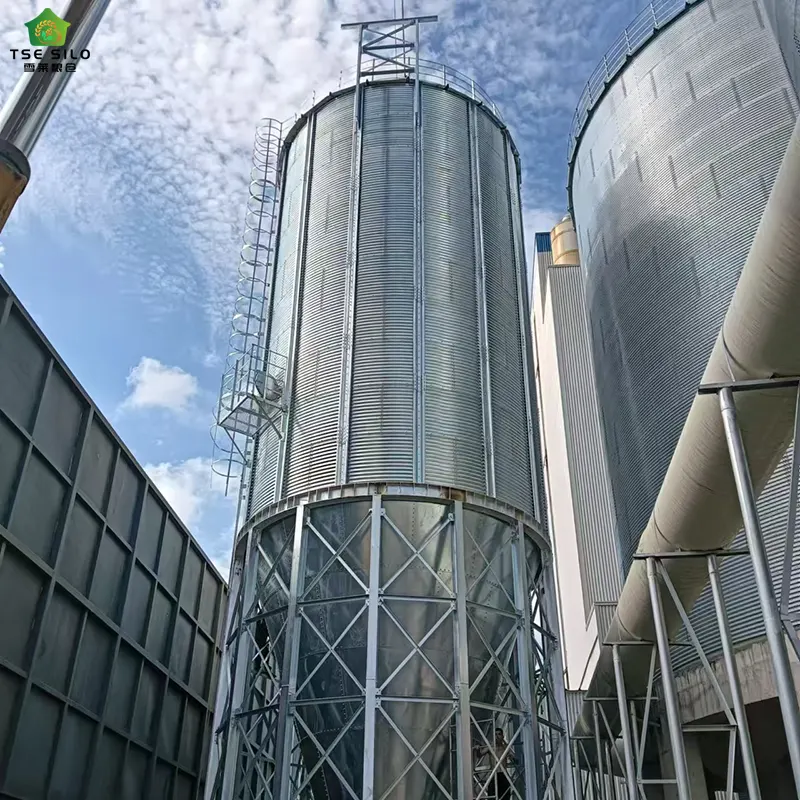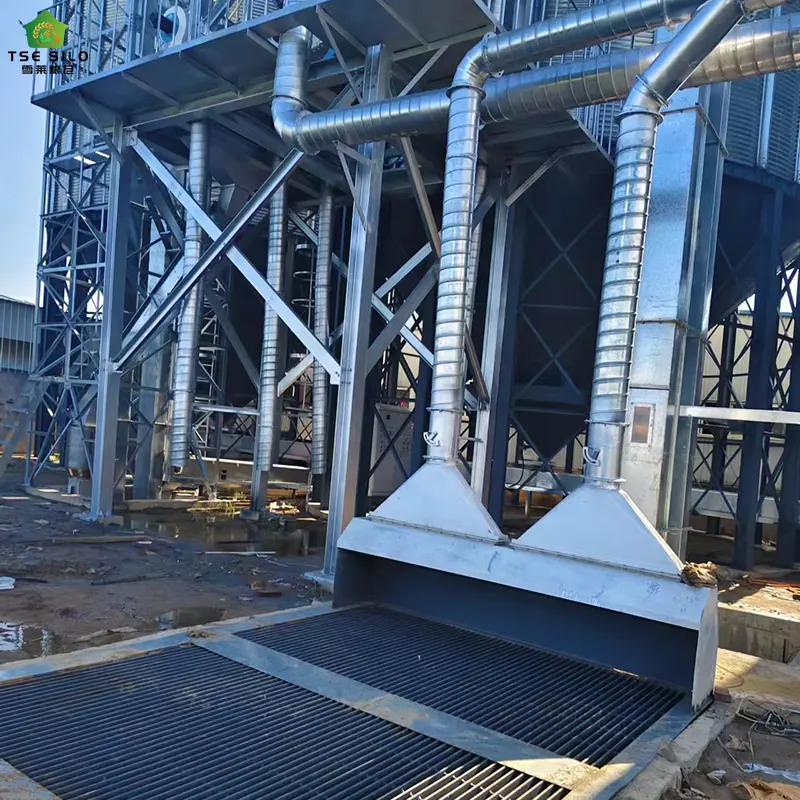The feed farming industry has a strong and growing demand for steel silos. Steel silos have gradually evolved from an "option" to a "standard feature" for modern, large-scale feed farming operations. This is fundamentally because feed silos perfectly meet the industry's core demands for storage safety, cost control, production efficiency, and modern management.


1. Storage Pain Points in the Feed Farming Industry (Why Do We Need Specialized Silos?)
1.1. Diversity of Raw Materials and Finished Products:
- Raw materials such as corn and soybean meal, as well as finished products such as compound feed and premixes, have different physical properties and require distinct storage conditions.
1.2. Stringent Requirements for the Storage Environment:
- Mold and Moisture Prevention: Moisture content in feed raw materials and finished products is a key indicator. Once exposed to moisture and mold, not only does it lose nutritional value, it can also produce toxins such as aflatoxin, which can harm animal health.
- Pest and Rodent Prevention: Pest and rodent infestations can directly cause material loss and contamination.
- Insulation and Condensation Prevention: Diurnal temperature fluctuations can easily lead to condensation in silos, a major cause of material compaction and mold.
1.3. High Demand for Production Efficiency:
- Large-scale farming requires a stable and timely supply of feed, which demands a warehousing system capable of rapid, large-scale loading and unloading, seamlessly integrated with the production line.
1.4. Enthusiastic Pursuit of Cost Control:
- Feed costs account for over 60%-70% of total farming costs. Loss control, energy consumption control, and labor costs in the warehousing process directly impact company profits.
2. Advantages of Steel Silos Compared to Traditional Storage Methods
Compared with traditional room-type silos and concrete silos, feed steel silos offer significant advantages:
| Comparison Dimensions | Steel Silos | Traditional Room-Type Silos/Concrete Silos |
| Construction Cost | Low, short construction period, high degree of standardization. | High, long construction period, complex construction. |
| Sealing Performance | Excellent: Professional sealing technology effectively prevents moisture, dust, and leaks. | Poor: Many doors, windows, and joints, making them susceptible to moisture and pests. |
| Mechanization and Automation | Easy to implement, can be equipped with conveying, metering, dust removal, temperature measurement, and ventilation systems for fully automated management. | Difficult, low space utilization, difficult and costly to automate. |
| Outflow Rate | High (>95%), special funnels and flow-aiding devices ensure clean material discharge, reducing residue and waste. | Low, many dead corners, prone to compaction, heavy manual cleaning work, and high residue. |
| Land Use | Economical, high-rise development, high land utilization. | Wasteful, large footprint. |
| Scalability | Strong, easy modular expansion and relocation. | Poor, essentially fixed structure. |
3. Specific Demand Analysis of Steel Silos in the Feed and Aquaculture Industry
3.1. Raw Material Storage
- Core Requirements: Safe, low-cost, and large-scale storage.
- Application Scenario: Receiving and storing bulk raw materials such as corn, soybean meal, and wheat.
- Safe Storage: Excellent sealing isolates external moisture. Combined with mechanical ventilation and temperature measurement systems, the silo environment can be actively adjusted to prevent heating and mold.
- Reduce procurement costs: Allows companies to conduct large-scale storage when raw material prices are low, reducing procurement costs.
- Reduce loss costs: Extremely low loss rates (controllable to within 0.2%) directly translate into profits.
- Reduce labor costs: Automated loading and unloading significantly reduces labor reliance.
- Increased Efficiency: Seamless integration with docks and railway terminals enables rapid unloading from trucks and ships and high-rise silo storage.
3.2. Production Process
- Core Requirements: Stable, continuous, and clean feed.
- Applications: Serving as buffer silos, pre-crushing silos, and pre-pelleting silos in production lines.
- Process Stability: Ensures a stable supply of materials upstream of the production line, avoiding production stoppages due to feed interruptions.
- Reduced Contamination: The closed system effectively prevents cross-contamination and external contamination, which is crucial for factories producing feeds with different formulas.
- Space Optimization: Within a limited factory area, a vertical layout optimizes logistics routes.
3.3. Finished Product Storage
- Core Requirements: Freshness preservation, mix-up prevention, and efficient shipping.
- Application Scenarios: Temporary storage and shipping of finished products such as compound feed and concentrated feed.
- Quality Preservation and Freshness Preservation: Maintains feed freshness and prevents oxidation and loss of vitamins and other nutrients.
- Clear Classification: Multiple independent steel silos can store finished products of different varieties and batches, enabling refined management and avoiding shipping errors.
- Fast Shipping: Direct connection to automatic packaging machines and bulk feed trucks through the silo bottom discharge port significantly improves shipping efficiency, making it particularly suitable for bulk feed distribution to large farms.
4. Differences in Demand Among Different Enterprise Types
Large Feed Groups/Integrated Farming Enterprises:
- Highest Demand. They typically require steel silos with a capacity of tens or even hundreds of thousands of tons to form a complete raw material, production, and finished product storage and logistics system.
- Large prefabricated steel silos (10-30 meters in diameter or more) are preferred, integrated with intelligent management systems (such as IoT-based temperature measurement, remote monitoring, and inventory management ERP integration).
Medium-sized feed processing plants:
- They are the primary customer base for steel silos. Demand ranges from several thousand tons to tens of thousands of tons.
- They are used for core storage of raw materials and finished products, pursuing cost-effectiveness and high efficiency. They are a key step in replacing traditional warehouses and achieving industrial upgrading.
Small livestock farms/family farms:
- Demand is relatively weak, but growing. Small spiral-rimmed steel silos (tens to hundreds of tons) are commonly used.
- They are primarily used for storing self-use raw materials (such as corn), addressing seasonal storage and preventing mold.


5. Potential Challenges and Precautions
Despite the huge demand, considerations remain when using steel silos:
- 5.1. Condensation risk: While this can be mitigated through insulation, lining, ventilation, and other measures, accurate calculations and selection based on local climatic conditions are essential at the outset of design.
- 5.2. Professional Maintenance: Regular inspections of the silo, anti-corrosion coating (especially in coastal areas), and electromechanical systems are required. This requires companies to possess certain maintenance capabilities or to sign a service agreement with the supplier.
- 5.3. Initial Investment: Although cheaper than concrete silos, small businesses still need to carefully plan this one-time investment.
- 5.4. High Moisture Requirements: The moisture content of incoming materials must be strictly controlled below the safety limit, otherwise the risks in a closed environment are increased.
Conclusion
The feed farming industry's demand for feed steel silos is both intrinsic and strategic.
- From a survival perspective, they serve as a "safeguard" that ensures feed safety and prevents mold and loss.
- From an operational perspective, they serve as a "profit amplifier" that reduces overall costs and improves operational efficiency.
- From a development perspective, they serve as the "infrastructure" for companies to achieve scale, automation, and intelligent management.
With increasing concentration and increasingly fierce competition in the feed farming industry, the demand for efficient, intelligent, and reliable feed silos systems will only grow stronger. In the future, "smart steel silos" that integrate the Internet of Things, big data, and AI algorithms will become standard equipment for leading companies in the industry.
Written by
Shandong Shelley Grain Steel Silo Co., Ltd
Editor Jin
WhatsApp : +86-18653877118
Email : shelley@cnshelley.com






